
Thysanocarpus is a small genus of plants in the family Brassicaceae known generally as fringepods or lacepods. These are small, erect annual herbs. The flat fruit capsule is generally round or oval-shaped with a wing that goes all the way around the pod, giving it a fringed look. The fruits hang from most of the length of the stem. The plants are native to the western United States.
Campanula angustiflora is a species of flowering plant in the bellflower family Campanulaceae. It is known by the common name Eastwood's bellflower. It is endemic to California, where it grows in the serpentine soils of the hills and mountains surrounding the San Francisco Bay Area. It is a flower of the chaparral plant community. This is a hairy annual herb producing a thin, branching stem up to 20 centimeters tall. The leaves are leathery in texture and oval in shape, measuring between 0.5 and 1 centimeter in length, with a few teeth along the edges. The bell-shaped flower is pale blue or white and just a few millimeters long. The fruit is a ribbed, spherical capsule.
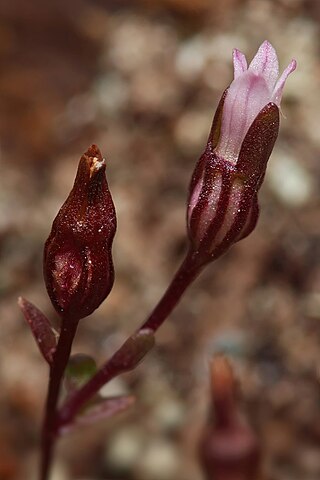
Ravenella griffinii is a species of bellflower known by the common name Griffin's bellflower. It is endemic to California, where it grows in the North and Central Coast Ranges in chaparral habitat on serpentine soils. This is an annual herb producing a thin, erect stem up to 20 centimeters tall. The leathery leaves are linear in shape, toothed along the edges, and less than a centimeter long. The stem and foliage are sometimes reddish in color and may have stiff hairs. The small, cylindrical flower is pale blue to white and less than 4 millimeters long. The fruit is an oblong, ribbed capsule.

Herissantia crispa is a species of flowering plant in the mallow family known by the common names bladdermallow and curly abutilon. It is native to the tropical Americas but it can be found throughout the tropical and warmer temperate world as an introduced species and sometimes a weed. This is a perennial or sometimes annual herb growing up to about 1.5 meters in maximum stem length, usually taking a trailing or creeping form. It is coated in whitish hairs. The oval or heart-shaped leaves are up to 7 centimeters long with rippled edges. The inflorescence is a solitary flower emerging from a leaf axil, borne on a long-haired pedicel which is half erect and then jointed downward. The flower has five pale yellow oval petals each up to a centimeter long. The fruit is a lantern-like inflated sphere ribbed into segments. It is up to 2 centimeters wide, coated in long hairs, and dehiscent, each segment containing 2 or 3 black kidney-shaped seeds.

Osmorhiza depauperata is a species of flowering plant in the carrot family known by the common names bluntseed sweetroot and blunt-fruited sweet-cicely.
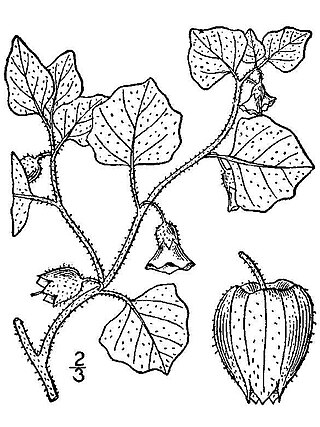
Physalis pubescens is a species of flowering plant in the nightshade family known by many common names, including husk tomato, low ground-cherry and hairy groundcherry in English, and muyaca and capulí in Spanish. It is native to the Americas, including the southern half of the United States, Mexico, Central and much of South America. It can be found elsewhere as an introduced species and sometimes a weed. It can grow in many types of habitat, including disturbed areas. This is an annual herb producing a glandular, densely hairy stem up to about 60 cm (24 in) in maximum height from a taproot. The oval or heart-shaped leaves are 3–9 cm (1.2–3.5 in) long and have smooth or toothed edges. The flowers blooming from the leaf axils are bell-shaped and about a centimeter long. They are yellow with five dark spots in the throats, and have five stamens tipped with blue anthers. The five-lobed calyx of sepals at the base of the flower enlarges as the fruit develops, becoming an inflated, ribbed, lanternlike structure 2–4 cm (0.79–1.57 in) long which contains the berry.

Physalis viscosa is a species of flowering plant in the nightshade family known by many common names, including starhair groundcherry, stellate ground-cherry and grape groundcherry in English, and arrebenta-cavalo, balãozinho, and camambú in Portuguese and Spanish. It is native to South America, and it is known on other continents as an introduced species and sometimes a weed. It can grow in many types of habitat, including disturbed areas.

Plagiobothrys stipitatus is a species of flowering plant in the borage family known by the common name stalked popcornflower and stipitate forget-me-not. It is native to Oregon and most of California, where it grows in vernal pools and similar wet habitat types. It is an annual herb producing a narrow, hollow, erect stem up to half a meter tall. It is coated in rough hairs. The pointed, hairy leaves along the stem are up to 11 centimeters long. The inflorescence is a series of five-lobed white flowers 2 millimeters to over one centimeter wide. The fruit is a narrow, ribbed nutlet.

Pyrrocoma apargioides is a species of flowering plant in the family Asteraceae known by the common name alpineflames. It is native to the western United States from the Sierra Nevada of California east to Utah, where it grows in the forests and meadows of high mountains. It is a perennial herb growing from a taproot and producing one or more stems to 30 centimeters in length. The stems are decumbent or upright, reddish, and hairless to slightly woolly. Most of the leaves are located around the base. They are thick and leathery, lance-shaped with large sawteeth along the edges, often center-striped in white, and measure up to 10 centimeters long. The inflorescence is usually a single flower head lined with centimeter-long phyllaries which are reddish to green with red edges. The head has a center of yellow disc florets and a fringe of ray florets which are yellow, often splashed with red along the undersides, measuring up to 1.6 centimeters in length. The fruit is an achene which may be well over a centimeter in length including its pappus.

Acleisanthes nevadensis is a species of flowering plant in the four o'clock family known by the common names desert moonpod and desert wing-fruit. It is native to a section of the southwestern United States encompassing southern Nevada and adjacent corners of Utah and Arizona. One occurrence has been observed in eastern California. The plant grows in desert habitat such as scrub and rocky washes. This herb produces several spreading stems up to about 30 centimeters in maximum length, sometimes from a woody base. The stems are covered in many leaves with fleshy oval or rounded blades up to 3 centimeters long which are borne on petioles. The herbage of the plant is coated in thick, wide, white, furry hairs, interspersed with shorter, flat hairs. Some hairs are glandular. Flowers occur in leaf axils. Each is a trumpet-shaped bloom with a narrow, tubular green throat up to 4 centimeters long and a round white corolla face about a centimeter wide, sometimes tinged yellow or greenish. There are five long, protruding stamens and a long style tipped with a spherical stigma. The fruit is a ribbed, hairy body with five broad, white wings.

Solanum parishii is a species of nightshade known by the common name Parish's nightshade. It is native to western North America from Oregon to Baja California, where it grows in many types of habitat, including maritime and inland chaparral, woodlands, and forests. It is a perennial herb or subshrub producing a branching, ribbed or ridged stem up to about a meter in maximum height. The lance-shaped to nearly oval leaves are up to 7 centimeters long and smooth-edged or somewhat wavy. The inflorescence is an umbel-shaped array of several flowers, each borne on a short pedicel. The flower corolla is around 2 centimeters wide when fully open and is usually purple, but sometimes white. At the center are yellow anthers. The fruit is a berry roughly a centimeter wide.
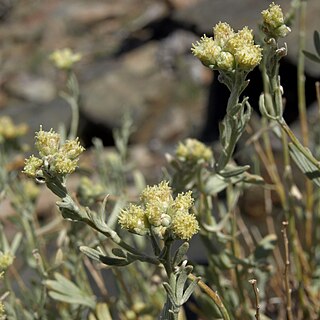
Sphaeromeria cana is a species of flowering plant in the family Asteraceae known by the common name gray chickensage. It is native to the western United States, where it is known from the Sierra Nevada, the adjacent desert ranges of eastern California and Nevada, and Steens Mountain of Oregon. It grows in dry, rocky mountain habitat, such as cracks and crevices, including the talus above the tree line. This is an aromatic subshrub with numerous erect branches growing up to 30 to 60 centimeters tall. It is gray-green in color and coated with woolly fibers. The leaves are linear or lance-shaped, the lower ones divided into lobes. The inflorescence is generally a cluster of flower heads lined with woolly phyllaries and containing yellow disc florets. There are no ray florets. The fruit is a ribbed achene about 2 millimeters long.
Tauschia glauca is a species of flowering plant in the carrot family known by the common name glaucous umbrellawort, or glaucous tauschia. It is native to the forests of Oregon and northern California, where it can often be found on serpentine soils. It is a perennial herb growing 20 to 40 centimeters tall. The leaves have blades which are divided into three-lobed leaflets and borne on long, thin petioles. The inflorescence is a compound umbel of yellow flowers with up to 12 unequal rays measuring up to 6 centimeters long each. The fruit is rounded, ribbed, and only 2 or 3 millimeters long.
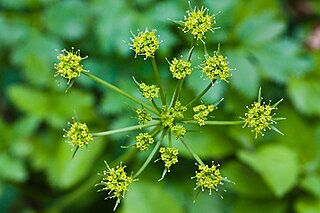
Tauschia hartwegii is a species of flowering plant in the carrot family known by the common name Hartweg's umbrellawort. It is endemic to California, where it is known from the Sierra Nevada foothills and some of the Central Coast Ranges. Its habitat includes coniferous woodlands and chaparral. It is a perennial herb growing 30 centimeters to one meter tall. It is coated in short, rough hairs. The leaves have blades which are divided into oval leaflets with serrated edges and borne on long petioles. The inflorescence is a compound umbel of yellow flowers with up to 30 unequal rays measuring 2 to 12 centimeters long each. The fruit is somewhat rounded in shape, ribbed, and under a centimeter long.
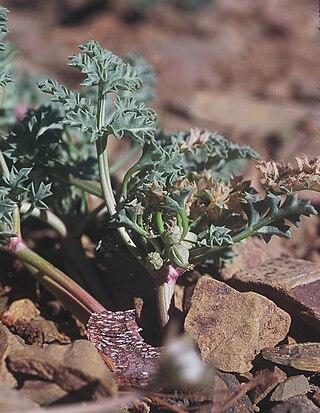
Tauschia howellii is a rare species of flowering plant in the carrot family known by the common names Howell's umbrellawort and Howell's tauschia. It is endemic to the Klamath Mountains of far southern Oregon and far northern California, where it is limited to nine occurrences in the Siskiyou Mountains. It grows in mountain forests on gravelly granite soils, often among stands of Shasta red fir. Despite its rarity it is stable and not considered very endangered. It is a perennial herb growing 30 to 80 centimeters tall. It is hairless in texture. The thick leaves have blades which are divided into leaflets large, sharp teeth and edges curved up, and borne on long petioles. The short inflorescence is a compound umbel of yellow flowers on a few short rays. The fruit is oblong, ribbed, and just a few millimeters long.
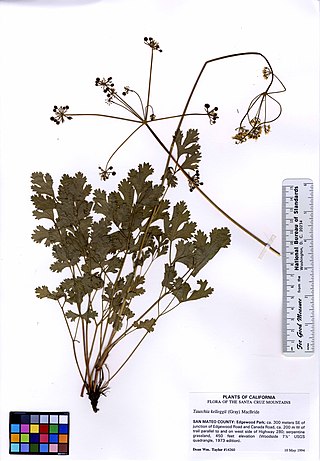
Tauschia kelloggii is a species of flowering plant in the carrot family known by the common name Kellogg's umbrellawort. It is native to the mountains of Oregon and the northern half of California, where it grows in chaparral, woodlands, forest, and other types of habitat. It is a perennial herb growing up to 70 centimeters tall. The leaves have blades which are divided into toothed or serrated leaflets, and sometimes subdivided further. The inflorescence is a compound umbel of yellow flowers with 10 to 20 rays measuring 2 to 12 centimeters long each. The fruit is somewhat rounded in shape, ribbed, and up to half a centimeter long.
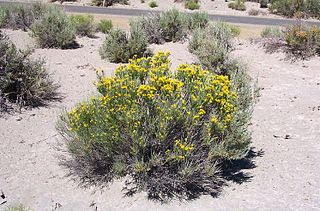
Tetradymia glabrata is a species of flowering plant in the aster family known by the common name littleleaf horsebrush. It is native to the western United States, especially the Great Basin and Mojave Desert. Its habitat includes sagebrush, woodlands, and scrub. It is an erect, bushy shrub growing to a maximum height over one meter, its stems coated unevenly in white woolly fibers with many bare strips. The narrow, pointed leaves are usually no more than a centimeter long and most occur in clusters along the branches. The inflorescence bears up to seven flower heads which are each enveloped in four woolly phyllaries. Each head contains four yellow cream flowers each around a centimeter long. The fruit is a hairy, ribbed achene with a pappus of bristles.

Thysanocarpus laciniatus is a species of flowering plant in the family Brassicaceae known by the common name mountain fringepod. It is native to California and Baja California, where it grows in many types of habitat. It is a common plant in much of its range. It is an annual herb producing a slender, branching or unbranched stem 10 to 60 centimeters tall. It is somewhat waxy in texture and generally lacks hairs. The leaves are linear to lance-shaped and smooth-edged or toothed. They measure up to 4 centimeters in length. The inflorescence is a raceme of small whitish or purplish flowers. The fruit is a flattened, rounded or oval disclike capsule with a thin wing around the edge.
Tripterocalyx crux-maltae is a species of flowering plant in the four o'clock family known by the common names Lassen sandverbena and Kellogg's sand-verbena.
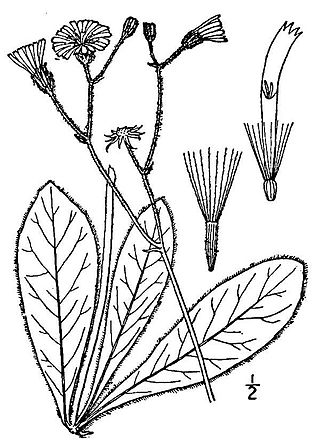
Hieracium traillii is a species of hawkweed known by the common name Maryland hawkweed.

















